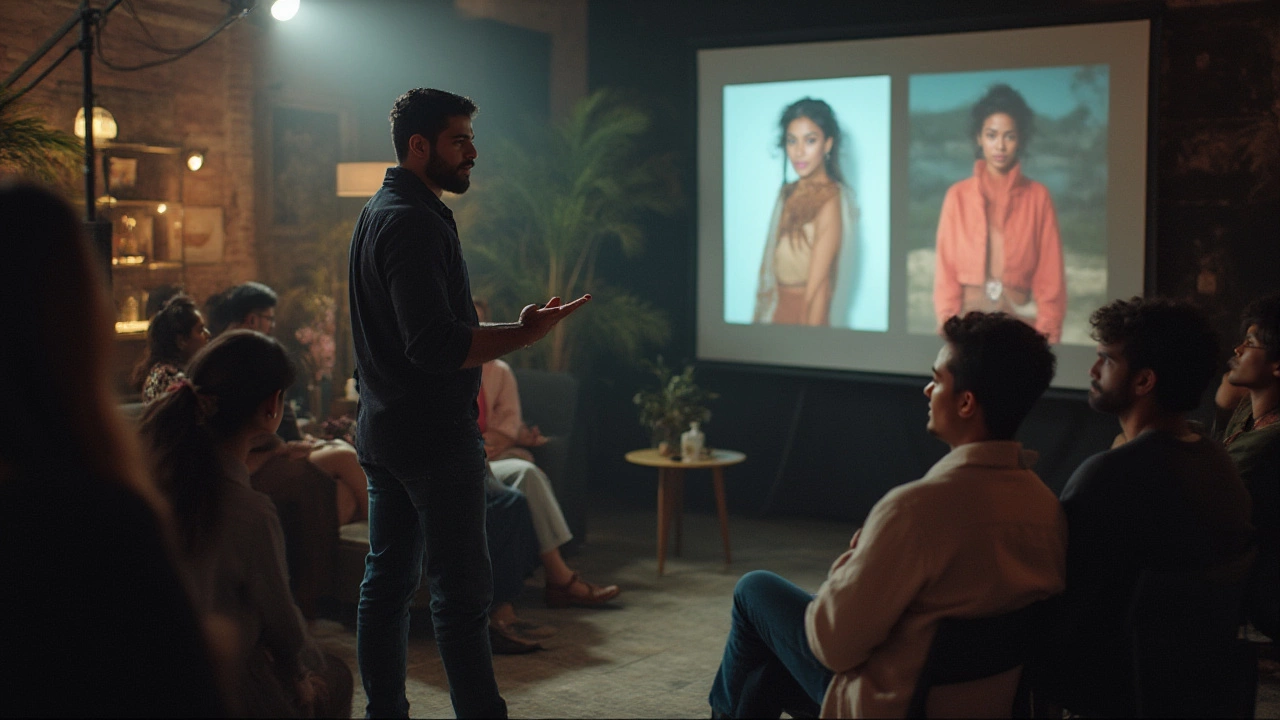Ready for a wild fact? According to Salary.com, the median annual salary for a professional photographer in the U.S. hovers around $55,000. That’s decent. But every year, thousands of photographers smash the six-figure ceiling. Some build luxury wedding empires. Others land lucrative licensing deals with global brands. Even more play smart and combine a handful of streams. If you’re stuck thinking it’s impossible—believe me, it’s not. But you can’t wing it. Want that six-figure magic? It’s a jumble of real work, creativity, and some ruthless business savvy. Here’s a brass-tacks guide to help you rewrite your financial fate behind the lens.
Building Your Brand and Portfolio for Premium Clients
Photographers who pull in six figures do more than snap beautiful pictures—they know how to be seen and remembered. Your camera skills matter, sure, but your brand is what makes you irresistible. One quick way to spot a six-figure shooter? They’re everywhere you want to be: front rows at fashion shows, headlining corporate events, their Insta feeds full of curated, signature looks. Start by asking yourself: what do I shoot best? Is it those intimate wedding moments, wild outdoor landscapes, punchy lifestyle portraits, or edgy commercial work? Niche down until you’re the first name people drop when they want that specific look.
You don’t need a studio full of high-end gear to start. Some of the most successful pros began with a humble DSLR and a thrifted lens. But they obsessed over quality—sharpness, mood, editing style—until their work glowed even on a crowded Instagram feed. High-end clients don’t just want nice photos. They want images with a point of view. Showcase your best in a polished portfolio: clean website, branded logo, concise bio. Try using platforms like Squarespace, Format, or even a visually tight Instagram grid to show your work. Avoid portfolio clutter. One iconic project beats thirty average ones.
Data time: In 2024, a CreativeLive survey revealed 70% of six-figure photographers spent at least 15 hours a week on marketing their brand. That means showing up—at exhibits, online, on podcasts, in creative collaborations. Networking isn’t just about chasing likes. It’s about forging industry connections, joining art shows, and working with local businesses. Redefine networking: start a small print show at a coffee shop, co-host a photo walk, or shoot a passion project for a non-profit. These acts stack brand value and get you in the right rooms.
Your online presence is a dealbreaker. SEO-savvy photographers use keywords like “NYC Wedding Photographer” or “Outdoor Adventure Headshots” to climb the Google ladder. But once people click, what do they see? A killer bio that reads like you’re a real person, not a robot. Trust is currency; let your story come through in your ‘About’ page. Swap stock photos for authentic behind-the-scenes shots. Testimonials are gold—ask happy clients to write about their experience. Don’t be shy with social proof; a sprinkle of logos from brands you’ve worked with, or publications you’ve been featured in, adds serious swagger.
Consistency is everything. From your editing style to your posting schedule, make sure people know exactly what to expect from you. Ever wonder how Annie Leibovitz's portraits are recognizable in seconds? That’s a signature style at play. Start building yours deliberately: set presets, create mood boards, challenge yourself with personal projects. Before clients invest big, they’ll want to see you have a vision—and the grit to stick to it.

Monetizing Photography: Diversifying Income Streams
Here’s what separates six-figure earners from the crowd: they never put all their eggs in one basket. It’s not just about snapping photos for clients and calling it a day. High-earners find, invent, and stack revenue streams to buffer slow seasons and fuel growth. Think of your photography like a musician’s catalog—a blend of hit singles, steady album sales, and occasional live gigs.
Start with your main services. Maybe you photograph weddings, shoot for magazines, or sell fine art prints. But don’t stop there. Experts like Jenna Kutcher and Chase Jarvis have built empires by teaching others through workshops, online courses, or even YouTube tutorials. If you know your craft, others will pay to learn. You don’t need a film crew—you just need your story, a webcam, and honesty about what works in your business.
Licensing is another game changer. Imagine you just shot a series of downtown cityscapes. Instead of letting them die on a hard drive, upload them to stock agencies like Getty Images, Adobe Stock, or even specialty platforms (think food, interior, or travel). Each download earns you passive income—often for years. Photographers like Michael Yamashita rake in thousands from licensing alone. According to a 2023 Shutterstock report, contributors who upload fresh, niche collections monthly out-earn stagnant portfolios by over 60% year over year.
If you love tangible art, prints and products open another door. Print-on-demand platforms (like Fine Art America or Society6) handle the dirty work—printing, framing, shipping—while you pocket a healthy margin. Or, go local: partner with cafes, boutiques, or gallery spaces to hang your work on consignment. Nothing beats the thrill of seeing your print on a living room wall—and that thrill pays. Limited edition runs often command higher prices, creating urgency and exclusivity.
Corporate gigs and retainer clients offer some of the steadiest paychecks. Think headshots for tech companies, annual reports, real estate portfolios, and advertising campaigns. These contracts can balloon into five-figure sums quickly, especially if you offer tiered packages (basic, premium, all-inclusive). Pitch yourself as a visual expert who solves a company’s marketing problem, not just a photographer with a day rate. Before long, you’ll be first in line for their next big launch or campaign.
Some pro tips: bundle services to boost your offer. Wedding photographer? Add video, photo booth, drone coverage, or engagement shoots at a package price. Travel to shoot? Upsell location scouting or same-day turnaround. Don’t ignore micro-commissions—quick product photos for Etsy sellers, branded content for local fitness coaches, and so on. These add up fast while building your network.
| Income Stream | Potential Annual Earnings (US) |
|---|---|
| Wedding Photography | $30,000 – $120,000 |
| Corporate/Brand Work | $20,000 – $80,000 |
| Licensing & Stock | $3,000 – $30,000 |
| Teaching/Workshops | $5,000 – $50,000 |
| Print Sales | $2,000 – $25,000 |
None of these streams are magic bullets, but together, they form a powerful safety net. Mix, match, experiment, and refine until you find the blend that fits your strengths—and your sanity.

Client Acquisition, Upscaling, and Working Smart
Hitting six figures isn’t just about working more; it’s about charging what you’re worth, finding dream clients, and getting brutally efficient. Start with your pricing. Too many up-and-coming pros undercharge, afraid higher numbers will scare people off. Guess what? Low prices signal beginner status. When you price strategically, you filter for clients who value your best work, not bargain hunters looking for a quick deal. The famous wedding photographer Jose Villa says, “If you’re fully booked every season, it’s time to raise your rates.”
Don’t just rely on fixed rates. Get creative with packaging. Offer tiered options—think bronze, silver, gold—each adding value and extras. Sweeten high-end packages with day-before shoots, priority editing, or luxury print albums. Communicate the transformation you offer. It’s not "just photos"—it’s legacy, brand equity, or life’s milestones, preserved forever. When clients see photography as investment, not expense, you’re playing in the right league.
Acquiring clients is really about visibility and trust. Use word of mouth—ask every client for referrals and reward them (a gift print, a discount on their next shoot). Collaborate with wedding planners, ad agencies, venue managers, makeup artists—anyone who touches your ideal client. Don’t be afraid to reach out to brands directly with a simple, clear pitch paired with a slice of your best work. Every big contract has a beginning—a single DM, email, or coffee chat.
Booking dream gigs often means making yourself unavoidable. Go to industry meetups, portfolio reviews, or local art crawls. Enter contests. Share behind-the-scenes stories that spark curiosity. If you’re remembered as “that photographer who shot the wild rooftop engagement session,” you’re more likely to be booked for the next big thing.
Time management is life-saving. Automate your admin: use software for contracts, invoicing, scheduling (like HoneyBook or Dubsado). Edit in batches and outsource retouching if possible. You’re the creative mind—stop spending Sundays buried in receipts. The more you value your time, the more others will, too.
Don’t skimp on continuing education. The photography world never stops moving. The rise of AI editing, drones, and 360 cams has reshaped the market. Stay sharp: follow industry leaders, buy the occasional workshop, and play with new tech before it hits mainstream. Show clients you’re ahead of the curve by weaving trendy (but tasteful) elements—think short-form videos for social, immersive virtual tours, augmented reality prints—into your offerings.
Real growth takes courage. You might mess up a shoot or lose a big contract. It happens to all of us (even the legends). Keep building your brand, improving your craft, and stacking revenue streams. The first six-figure year feels hard. The second comes easier. Keep learning, experimenting, and working smart—one client, one photo, one leap at a time. There’s plenty of room at the top for bold, creative photographers determined to pull in photography business income worth bragging about.





